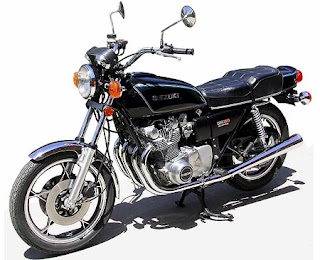Tuesday, June 14, 2011
1978 Gs 750 e
Arguably, the Suzuki GS750 was the first superbike from Japan to get it right. Sure, the CB750 hit the showrooms 7 years earlier and the faster Kawasaki Z900 came into production four years before the Suzuki. But neither of those handled particularly well. The Honda was akin to that of current day middleweight cruisers when it came to power and handling, whereas the Kawasaki had enough motor to totally overpower its chassis, enough so that it could really bite an inexperienced rider.
But not so the Suzuki. For the first time, you could buy a superbike that had a chassis good enough to handle the stock power as well as a bit of engine tuning. At the time, 1976, that was virtually unheard of for a big and fast motorcycle, and it was only fitting that it was brought forward by the last of the Big Four to introduce a four-stroke motorcycle. Because up to that day, Suzuki had made exclusively two-stroke engined motorcycles.
The new inline four had more than a superficial resemblance with the Kawasaki 900. They shared virtually the same cylinder bore, crankshafts, camshafts and the exact same valve sizes; heck, they even shared the very same valve adjustment shims and valve timing! Surprisingly, and disappointingly, the smaller Suzuki engine was 25 mm wider than that of the Z900. As a little consolation, it had a new feature in form of a fully automatic cam chain tensioner, relieving the owner of this typical maintenance task.
Modern riders who take liquid cooling, fuel injection, 4 valve cylinder heads and close to 200 hp per litre for granted may not be impressed by the old Suzuki, which only made half the power from its air cooled DOHC engine. It also sported a lowly two valves per cylinder and was fed by 26 mm slide carburettors. But despite not being particularly modern even by its day, it performed very well compared to the competition.
Suzuki claimed 63 hp for its first four-stroke, which was uncommonly modest for its time. Honda said their 750 made 67 hp back in 1969 and Kawasaki meant their 900 was good for 82 hp in ‘73, but in reality few met the claims made. The Suzuki, on the other hand, typically made around 60 hp at the rear wheel, suggesting somewhere just shy of 70 at the crank. It easily reeled off quarter-mile runs in the twelve’s, half a second quicker than the Honda 750. Really strong runners could reach 200 kph with a prone rider. Power delivery was quite peaky, with most of the muscle resting between 6 and 10,000 rpm, although in typical inline four fashion the engine was highly flexible and would pull from idle in top gear.
The chassis featured a swingarm resting in needle bearings in a time when bronze or plastic bushings were the norm. In addition, the swingarm itself was pretty hefty compared to that of the competition, as was the frame. Wheelbase was substantial at almost 1500 mm, speaking for great stability at high speeds. Rake and trail where more radical to ensure reasonably quick steering despite the long chassis Suspension was supple, yet controlled, and was what set the Suzuki apart from any other big bikes of the era. Up until then you could have a stiffly sprung bike with good handling or a softly sprung bike with comfort, but hardly anything with comfort and handling. And only the Z900 had more cornering clearance in stock form - although it had plenty more.
Cycle magazine described the chassis like this in their original test: “For 99 percent of all riders the GS750 is an awfully good handler, and for 100 percent of all riders it sure has comfortable suspension.” It definitely was the best amalgam of power, handling, comfort and versatility money could buy in 1976.
Although the GS750 only lived for 3 years before being replaced by the GSX750, Suzuki found time to produce it in basically three different disguises; standard, luxury and cruiser. The standard model had wire wheels and a single disc brake up front and another at the back, although it had twin front discs up front at some markets. The luxury model, called GS750E, was mostly the same bike with cast wheels and a slightly stepped seat. It also had three disc brakes of a different design. The cast wheels made it heavier and the increased unsprung weight confused the suspension a bit. The final model was the cruiser, or Low Slinger, called the GS750L. It featured shorter mufflers, a smaller teardrop shaped fuel tank, a heavily stepped seat, cast wheels and a single disc brake at both ends. The mufflers robbed some power and together with the tall, wide and dastardly uncomfortable handlebars this made the bike 15 kph slower in top speed.
One of the finest assets of the GS750 was its amazing reliability. Just like the Z900, the engine was so over-engineered that when Suzuki introduced the GS1000 based on the same design, it had smaller bearings and a lighter, thinner crank and crankcase. In fact, even these crankcases were strong enough to cope with 500 hp or more in supercharged drag racing engines without modification! Later, there were also 850 and 1100 cc versions of basically the same engine, both featuring shaft final drive. There were also shaft drive versions of the 750 and 1000, although the smallest shaftie was for the domestic market only.
So why on earth did Suzuki overbuild their first four-stroke to this degree, knowing that it would cost both money and weight? Because they simply couldn’t afford a failure! Their two-strokes were old-fashioned and had a reputation as slow, yet sturdy workhorses. A few years before the GS750, Suzuki tried to revolutionize the motorcycling world with the RE-5. It featured a wankel engine fitted basically to the GT750 chassis. And it failed miserably. It was complicated, it lacked reliability, it lacked performance, it guzzled fuel and the chassis was passé before it hit the streets. The GS750 was an improvement in every respect over the GT and RE - and it had to be. Suzuki’s survival depended on the GS series, which soon expanded to cover all sizes and categories. Today, the simple and reliable format continues in the GS500 twin, a no frills bike for those seeking cheap and reliable transport.
In some ways it was the Gixxer of its day, a state-of-the-art motorcycle, but it wouldn’t make sense to compare the two for anything but to see how far the world has moved over the past 30 years, because the GS was intended to be much more versatile than the Gixxer ever was. Actually, the bikes dating that far back cannot easily be compared to anything made today. Sure, there are retro bikes like the CB750 that feature semi-modern technology while trying to look like the old bikes, but nobody could call this genre state-of-the-art any more.
But if we just for fun compare the GS to the most extreme motorcycle of today in the same class, the GSX-R750, it will give you an idea of what sort of gains that have been made and how lucky current riders are to live in a time when you can buy track-worthy technology right off the floor at a very friendly price. Over the years, weight has dropped from 253 to 195 kg with fuel, the number of valves have doubled to 16, liquid cooling have replaced cooling fins, advanced digital injection has replaced a quartet of carburettors, claimed power has increased from 63 @ 8800 to 150 @ 12800, top speed has increased from 195 to 275 kph and acceleration from 0-100 kph has dropped from 4.5 to 3.0 seconds.
Of course, these hard facts only tell part of the story. When it comes to handling and brakes, the improvements are at least as big, and a good rider on a current motorcycle can ride faster and still remain safer than the riders of three decades ago. When it comes to comfort and touring abilities, however, the old style may be preferred by many even today, particularly those forced to ride pillion. The flat seat makes it easy to move around and both rider and pillion are seated on the same plane and can stay close together in a natural way.
The closest modern soul-mate to the old GS is probably not a Suzuki at all, but the Z750 from Kawasaki. This is kind of funny, because its closest competitor back in 1976 was another Kawasaki, the Z650, and not the other 750s. The Kawasaki had a smaller engine, but it was also lighter and a decent handler in its own right. Although the 650 engine was rated at one hp above the GS750, the reality was that the Suzuki made more power. However, the Kawasaki pulled nicely in the midrange and didn’t require as much shifting of gears to go briskly, also helped by shorter gearing and the already mentioned lesser weight.
The current Z750 is of course a much stronger performer than the old GS, but it has retained the same basic idea; a straightforward motorcycle to be used as a platform to build a machine to your own ideas. Just as the old Suzuki, the new Kawasaki can be upgraded to have a go at the track or it can be fitted with a better seat and saddlebags and be made into a sports tourer. Left stock, both the Z and GS can/could be used to go scratching back roads on Sundays, commute with ease on workdays and hit the open road on holidays with a bit of soft luggage to carry required belongings
Subscribe to:
Post Comments (Atom)





No comments:
Post a Comment